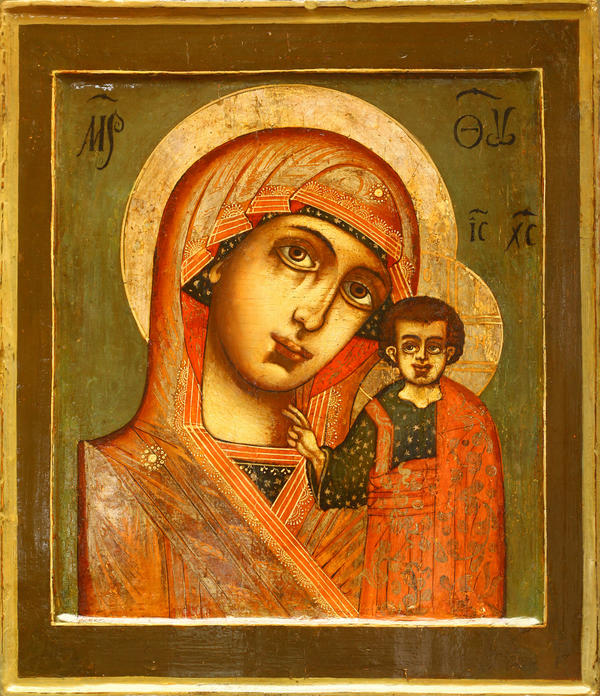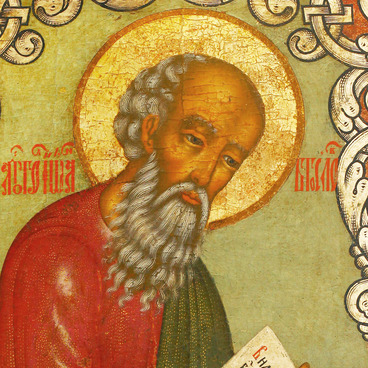Our Lady of Kazan was delivered to Museum of Local History of the Republic of Mordovia from the church of Saint John the Apostle in 1938. It is believed that Our Lady of Kazan is a simplified variant of Hodegetria, a famous image of the Virgin Mary with the Christ Child on her hands, according to legends, painted by Luke the Evangelist. Nevertheless, it can be considered an individual iconographical image unique in the art of the 16th century.
The main peculiarities of the icons are the bust-length image of the Virgin Mary and the posture of the Christ Child painted full-length in the foreground. His right hand is raised in a two-fingered blessing, his left hand is under a himation, a rectangular mantle of the ancient Greeks. The general style of performance of the icon, peculiarities of its setting, elaborate decoration of vestments with silver and a light-to-dark modeling of faces are typical of traditions of Russian icon painting of late 17th century.
Characteristic features of the painting style, such as rather massive lips, heavy chin, vacant stare unusual in icon painting, do not help to create an appropriate image of the Christ Child. However, the combination of quiet green, red and brown colors proves the painter’s refined manner of painting and his excellent sense of color. Numerous details and careful depiction of the vestments of the Virgin Mary and the Christ Child do not impede the perception of the painting but, on the contrary, they make the image completed.
The icon of Our Lady of Kazan is a unique masterpiece of that epoch, a combination of traditions of Old Russian artists and elements of European painting school penetrated into Russian icon painting due to reforms implemented by Peter the Great.
The feast day of Our Lady of Kazan is celebrated twice a year, such as on July 21, to commemorate the recovery of the icon in Kazan and on November 4, to commemorate the liberation of Moscow from the Polish invaders.
Our Lady of Kazan is one of the most revered icons in Russia. According to an ancient legend, the Virgin Mary appeared three times before a small girl called Matrona in her dream and pointed to the ruins of a burnt house under which the icon was hidden. Matrona told the priest about her wonderful dream and the image of the Virgin Mary was really discovered in that place.
At the turn of the 16th and 17th centuries during the Time of Troubles, the Polish troops invaded Russia and seized Moscow. It was one of the most difficult periods in the history of our country. Nevertheless, some Russian people were ready to do their utmost to save the Motherland. One of the main leaders and fighters for the national unity of Russia was Patriarch Hermogenes. At his request, the wonderworking icon of Our Lady of Kazan was delivered from Kazan to help the liberating forces and become the main icon of the Russian volunteer army.
In the spring of 1612 the Russian Volunteer Army headed by Kuzma Minin, a rich merchant, and Prince Dmitry Pozharsky set out to liberate Moscow besieged by foreign invaders. A copy of the icon of Our Lady found in Kazan accompanied liberators in their campaign, giving them strength and inspiring hope. On October 22 (November 4, new style) the volunteer army liberated the main part of the town and several days later they took the Kremlin under their control.
Following the order of Tsar Mikhail Fyodorovich Romanov and with the blessing of Patriarch Filaret, a special holy day was established to commemorate the liberation of Moscow from the Polish invaders. Every year on October 22 (November 4, new style) the image of Our Lady of Kazan was to be honored with a Holy Cross Procession in Moscow. Before 1649 celebrations were held only in two cities, namely Moscow and Kazan but later they became national.
The main peculiarities of the icons are the bust-length image of the Virgin Mary and the posture of the Christ Child painted full-length in the foreground. His right hand is raised in a two-fingered blessing, his left hand is under a himation, a rectangular mantle of the ancient Greeks. The general style of performance of the icon, peculiarities of its setting, elaborate decoration of vestments with silver and a light-to-dark modeling of faces are typical of traditions of Russian icon painting of late 17th century.
Characteristic features of the painting style, such as rather massive lips, heavy chin, vacant stare unusual in icon painting, do not help to create an appropriate image of the Christ Child. However, the combination of quiet green, red and brown colors proves the painter’s refined manner of painting and his excellent sense of color. Numerous details and careful depiction of the vestments of the Virgin Mary and the Christ Child do not impede the perception of the painting but, on the contrary, they make the image completed.
The icon of Our Lady of Kazan is a unique masterpiece of that epoch, a combination of traditions of Old Russian artists and elements of European painting school penetrated into Russian icon painting due to reforms implemented by Peter the Great.
The feast day of Our Lady of Kazan is celebrated twice a year, such as on July 21, to commemorate the recovery of the icon in Kazan and on November 4, to commemorate the liberation of Moscow from the Polish invaders.
Our Lady of Kazan is one of the most revered icons in Russia. According to an ancient legend, the Virgin Mary appeared three times before a small girl called Matrona in her dream and pointed to the ruins of a burnt house under which the icon was hidden. Matrona told the priest about her wonderful dream and the image of the Virgin Mary was really discovered in that place.
At the turn of the 16th and 17th centuries during the Time of Troubles, the Polish troops invaded Russia and seized Moscow. It was one of the most difficult periods in the history of our country. Nevertheless, some Russian people were ready to do their utmost to save the Motherland. One of the main leaders and fighters for the national unity of Russia was Patriarch Hermogenes. At his request, the wonderworking icon of Our Lady of Kazan was delivered from Kazan to help the liberating forces and become the main icon of the Russian volunteer army.
In the spring of 1612 the Russian Volunteer Army headed by Kuzma Minin, a rich merchant, and Prince Dmitry Pozharsky set out to liberate Moscow besieged by foreign invaders. A copy of the icon of Our Lady found in Kazan accompanied liberators in their campaign, giving them strength and inspiring hope. On October 22 (November 4, new style) the volunteer army liberated the main part of the town and several days later they took the Kremlin under their control.
Following the order of Tsar Mikhail Fyodorovich Romanov and with the blessing of Patriarch Filaret, a special holy day was established to commemorate the liberation of Moscow from the Polish invaders. Every year on October 22 (November 4, new style) the image of Our Lady of Kazan was to be honored with a Holy Cross Procession in Moscow. Before 1649 celebrations were held only in two cities, namely Moscow and Kazan but later they became national.



